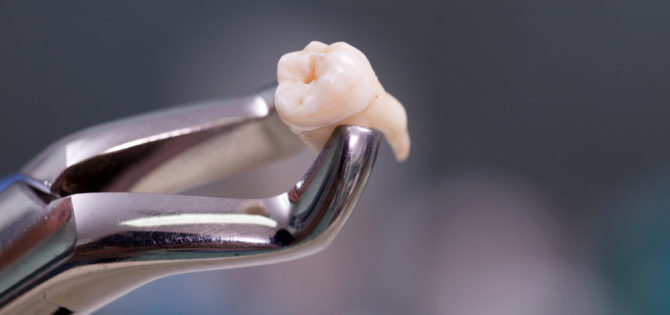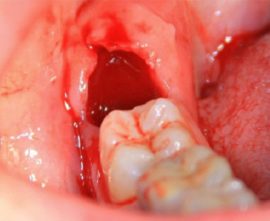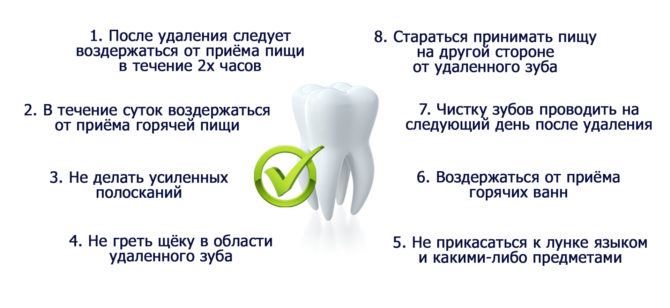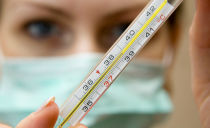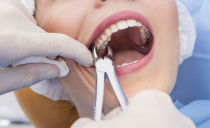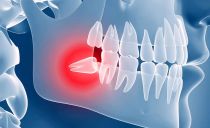Recommendations after removing the wisdom tooth: when you can eat and drink, especially care
Infection and inflammation of the well often becomes a consequence of the extraction of molars. Especially difficult is the healing of the hole from under the "eight". Dentists always warn about what to do after removing a wisdom tooth, how to prevent complications. But even before the procedure, the patient does not hurt to find out about the basic, generally recognized rules of nutrition and oral care after extraction.
Content
Indications for the removal of the "eight"
A direct indication for the removal of the third molar may be:
- inflammatory process in the root;
- cyst;
- compression of the branches of the trigeminal nerve;
- lack of space;
- caries;
- anatomically incorrect position, due to which a chronic bite of the soft tissues of the cheek develops;
- pathological location inside the jaw, resulting in pressure on adjacent teeth.
In all these situations, one needs to part with the wisdom tooth. The decision to remove is made by two doctors: a dentist and maxillary surgeon. The first is obliged to correctly assess the clinical picture, the second - to think over the course of the operation.
How is the removal
At the preparatory stage, the dentist examines, interviews the patient and examines an X-ray to determine the position of the roots. Before the procedure, the person receives general anesthesia or local anesthesia (depending on the difficulty of access). Then the surgeon pulls the upper part of the tooth with forceps and removes the debris from the gum. The resulting hole is disinfected.
In special situations, the doctor may decide to sew up, tighten the edges of the hole with threads, in other cases, the patient goes home to recover.
Nutrition and care after wisdom tooth extraction
Immediately after surgery, the doctor will close the wound with a sterile cotton swab. You can not remove it from the oral cavity within 30 minutes, during this time the bleeding will stop completely, a blood clot will form that protects the cavity from germs, bacteria. It is forbidden to remove, clean out a clot without the advice of a doctor.
First day
On the first day after the procedure, it is better to stay at home. If the condition allows, you can sleep. The doctor will prescribe pain medication for acute pain; you should not refuse them. They not only improve well-being, but also contribute to the relief of inflammation.
Special recommendations regarding nutrition. 3 hours after the removal of the wisdom tooth, when it is already possible to drink and eat, it is allowed:
- drinks at room temperature;
- liquid dishes;
- mashed soups;
- porridge.
You need to eat a teaspoon, not wide opening his mouth. Drinks are more convenient to drink through a cocktail tube. It is necessary to ensure that pieces of food do not fall into the hole, liquid is not poured, for this, food should be put on the side opposite to the wound.
Important! In the evening of the first day, you must refuse to brush your teeth so as not to damage the clot. The maximum that can be done is to gently rinse your mouth with cooled boiled water.
The second or third day
A few days after the tooth was removed, the jaw will hurt, which is absolutely natural. Also, many dentists consider it normal to increase the temperature to 38.5 ° C. If the temperature rises to 39–40 °C, and the pain does not decrease under the influence of painkillers, you need to urgently call an ambulance or go to the dentistry on call.
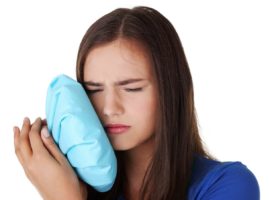 On the second and third day after the procedure for removing the wisdom tooth, you can do cold compresses. Slices of ice, frozen foods and heating pads filled with cold water should be wrapped on top with a soft cloth that protects the skin from frostbite. It is also worth following the recommendations of the attending physician:
On the second and third day after the procedure for removing the wisdom tooth, you can do cold compresses. Slices of ice, frozen foods and heating pads filled with cold water should be wrapped on top with a soft cloth that protects the skin from frostbite. It is also worth following the recommendations of the attending physician:
- eat liquid food (the diet may include thick mushy soups);
- avoid hot and cold;
- refuse sweet, spicy and sour;
- drink the prescribed medicine.
Do not chew food on the side with which the tooth was removed, brush the wound. During this period, rinses with herbs are already allowed, care for the damaged gum should be done with decoctions of chamomile, oak bark or sage. Rinse the oral cavity carefully - too active actions will inhibit recovery.
Important! When the temperature rises again (the temperature rises, then normalizes and rises again after 3-4 days) and with an increase in toothache, you need to consult a dentist. Despite proper care, inflammation can develop after removing a wisdom tooth. Only a doctor can assess its scope and severity of the situation. Repeated fever and pain in the affected gum area are symptoms of a complication.
The end of the first week and the beginning of the second
If all recommendations after the removal of the wisdom tooth are observed, by the end of the first week there is noticeable relief: the wound is healed, the pain recedes. In case of complications, the doctor will prescribe an additional medicine - an antibiotic. The tablets are drunk in a course until a lasting therapeutic effect is obtained.
You can’t cancel the antibiotic prescribed by your doctor yourself. Such diseases as alveolitis, inflammation of the gums, phlegmon can develop.
Nutrition after removing a wisdom tooth should remain sparing for two weeks. You can make fruit purees, eat boiled vegetables, and drink non-hot herbal tea. When the wound heals, you can diversify the diet: include fresh fruits, meat and fish dishes in the menu.
Sport
Everyone knows that within 3-4 hours after removing a wisdom tooth, everyone knows, and few are aware of how many days you need to avoid heavy physical exertion. Doctors often forget to warn patients before discharge.
When pulling out a tooth, the integrity of a large number of blood vessels feeding its root is violated. The faster they heal, the less chance of complications. When the body receives physical activity, blood circulation intensifies - pressure on injured vessels increases. In this regard, you can not attend a fitness studio, lift weights, swim and perform any active actions for two weeks after extraction.
Smoking
Cigarettes will also have to be removed for a while. Hot tobacco smoke causes bleeding and can dissolve a protective blood clot. The cork will come out and a wound will remain open in the hole for infection. This will not only complicate care, but will increase the healing time of the wound and lead to complications.
Disturbing symptoms of the first month
Some symptoms of malaise during the first month after extraction may be due to the fact that a person has recently had a tooth removed. In addition to swollen cheeks, pain and temperature, the patient should be alert:
- unusual headache;
- persistent putrid breath;
- throbbing pain in the jaw from which the "wise" tooth was pulled out;
- numbness in the gums;
- enlarged lymph nodes located near the operation site.
After the patient visits the clinic, the doctor will examine his oral cavity, prescribe an x-ray or open the gum. Its task is to eliminate the focus of inflammation, to suppress the spread of bacterial infection. Since all procedures are painful, anesthesia will be performed.If the patient drank painkillers before visiting the dental clinic, he should notify the doctor.
Important! It is forbidden to independently open abscesses and abscesses, take antibiotics without a dentist. Illiterate treatment of the wound, the wrong choice of the drug contribute to the development of inflammation, general intoxication of the body.
Therapeutic bath recipes
Since with an active mouth rinse you can break the protective clot, dentists recommend doing therapeutic baths instead. The most effective:
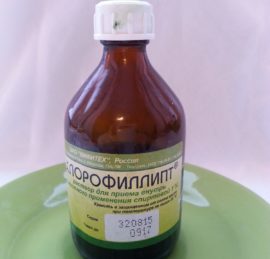 Decoctions of calendula and eucalyptus (3 tablespoons per cup of boiling water).
Decoctions of calendula and eucalyptus (3 tablespoons per cup of boiling water).- Chlorophyllipt (ready-made pharmaceutical product).
- Saline solution (25 grams per glass).
- Miramistin.
- Chlorhexidine.
It is very convenient to make baths on the lower jaw - just put the solution in your mouth and hold it for 4 minutes and spit it out. Under gravity, the liquid will penetrate all inaccessible places and provide effective anti-inflammatory care.
It is much more difficult to care for the hole after removing the upper tooth of wisdom (and you have to pull it out as often as the lower one). The recipes can be used the same, but the methods should be different:
- for the correct location of the liquid in the mouth, you need to tilt your head to the side (in the direction on which the operation was performed);
- the second option is a gauze application (you need to moisten a folded sterile napkin with a medicinal infusion and put on the gum).
Important! Neither cotton wool can be used to treat the upper or lower jaw. Its fibers remain in the wound and can cause suppuration. To care for the hole, you can use only sterile bandages and gauze napkins.
A brief set of rules
Even with careful preparation for the operation, the patient’s condition after they pulled out a hard-to-reach third molar is far from ideal. During this period, it is difficult to remember all the tips: how to care for a wound, what to exclude from normal nutrition. For convenience, all the main recommendations are shown in the illustration:
Looking at it, it is easy to remember how much you can eat after removing a wisdom tooth, when to clean the oral cavity, how to eat right. Compliance with the basic rules will help keep the hole in order and avoid complications.

